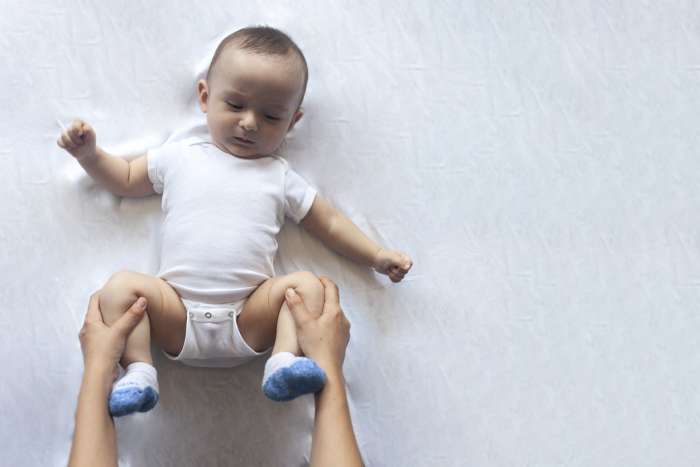Babies that are born with their heads to one side may have torticollis. Find out what torticollis is, how it's diagnosed, and what the symptoms and treatment options are.
What Is Torticollis?

Some babies are born with their heads tilted to one side. Others may develop this after birth. This is called torticollis. If you think your baby has this, try not to be concerned. It won’t go away on its own; however, with the right physical therapy exercises such as stretches, position changes, and exercises, your baby’s head can return back to a normal position.
Torticollis (also called wryneck) is a condition where a baby’s neck muscles tighten in a way that causes their heads to twist and rotate to one side. Their head has a limited range of motion. Although most cases are congenital, torticollis can also develop up to three months after birth. It can affect both male and female babies.
In congenital torticollis, the specific neck muscles that tighten are called the sternocleidomastoid muscles (SCMs). These muscles run from the back of the skull to the collarbone.
Researchers aren’t sure why congenital torticollis occurs but they think it may happen when:
Is Karo Syrup Safe for Babies? Why This Constipation Cure Can Be Toxic
Years ago, people used to suggest using Karo syrup for babies’ constipation. New evidence shows that using dark corn syrup for infant constipation is a bad idea. However, there are other home remedies that you can safely use to treat your baby’s constipation. Read More
- The fetus stayed in an unusual position for too long, such as a breech position
- Forceps or a vacuum was used during delivery
- Childbirth was difficult
- There wasn’t enough room in the uterus and this caused the baby to cramp inside
In these situations, extra pressure is put on the sternocleidomastoid muscles, making them tighten on one side and causing your baby’s stiff neck.
Related: 8 Things Your Newborn Will Do That Might Surprise You
What Are the Symptoms of Torticollis?
A baby with torticollis will act and behave like other babies. The only difference is that those with torticollis will have trouble turning their head.
Torticollis may be apparent if:
- Your baby’s head is twisted and rotated such that it tilts to one side and the chin tilts in the opposite direction.
- Your infant has a restricted range of motion regarding their head and neck. They are unable to make a complete turn from one side to the other with their head.
- Your baby’s neck muscles are swollen, tight, and/or stiff
- Your baby may prefer to breast or bottle feed on one side only as it is more comfortable
- When looking at a moving object, your baby has trouble moving its head to one side and gets frustrated it’s not able to fully rotate its head.
- There is a muscle knot or small lump on your baby’s neck muscle.
- Your baby may have positional plagiocephaly which means their head shape has a flat spot due to constantly laying on one side.
How Is Congenital Muscular Torticollis Diagnosed?
Typically, your baby can be diagnosed with torticollis six to eight weeks after birth. To properly diagnose whether your baby has torticollis, a pediatric doctor or healthcare provider will do a physical exam.
They will check whether your baby’s neck muscles are tight or swollen, if there are knots or lumps in the muscles, how far your baby can turn their head, and how severe the head tilt is.
If your baby’s condition is severe, your healthcare provider may order further tests such as a neck X-ray, head and neck magnetic resonance imaging (MRI) scan, and/or a head and neck computed tomography (CT) scan.
What Are the Treatment Options for Torticollis?

Depending on how severe your baby’s condition is, it could take between 6 months to over a year to gain a full range of motion.
Typically, your doctor will provide you with a treatment plan that involves gentle stretching exercises and position changes. The purpose of treatment is to help relax the tight neck muscles and condition the weaker neck muscles on the opposite side. Doing so will help return your baby’s head position to an upright one.
It’s important to begin treatment as soon as your healthcare provider says it is safe to do so. This is usually between 3 and 6 months old. Early intervention can help prevent your baby’s condition from getting worse, minimize long-term consequences and avoid a potential surgery later.
Be sure to do the exercises regularly and consistently. At first, this could be done several times a day. As your baby gets stronger and the exercises seem easier, gradually increase the frequency and duration.
Your baby’s healthcare provider will typically follow up every 2–4 weeks to see how they’re progressing.
Here are some strengthening and stretching exercises you can do at home to help your baby’s torticollis:
- During naps and when they go to bed, put your baby to sleep with their preferred side facing the wall. Infants gravitate towards looking inside the room which will encourage them to turn to the weaker side of the neck and stretch their tight neck muscles. To prevent SIDS (Sudden Infant Death Syndrome), always put your baby to sleep on their back.
- During their awake time, place them on their back and put toys on their weaker side. Sit beside the weaker side of the neck, and try to entice your baby to look at you. Make funny noises, turn on sound-making toys and call for them. They will want to look at you and the toys so they will need to practice moving their head to their non-preferred side.
- During bottle or breastfeeding, change the position so that your baby will need to turn towards its weaker side.
Tummy Time for Torticollis
Doing lots of tummy time is crucial for all babies but can be extremely helpful for those with torticollis.
Tummy time is done when your baby is awake and with supervision. It involves placing your baby on their belly for a short time to help tone their neck, back, and shoulder muscles.
Sit on their non-preferred side. Encourage your baby to look at you by singing and talking to them. Start with 10–15 minute sessions and slowly increase as your baby becomes stronger.
At first, it can be uncomfortable for your baby as they are still learning to do this; however, with practice, your baby will find it easier as their weaker muscles strengthen and their tight muscles stretch out.
If conventional treatment does not seem effective, your pediatrician may also refer you to a specialist such as an orthopedist, neurologist, or physical therapist.
—
Find even more development activities that will help your baby’s growth, muscles, and reflexes with these 12 Simple Developmental Activities to Try with Your Tot.



